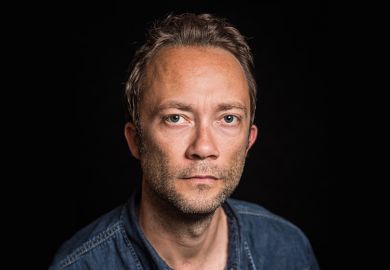Garfield (the large orange cat, not the 20th president of the US) is an unlikely hero in this frantic world of neoliberal “leaning in” and ruthless joy-sparking. American cartoonist Jim Davis created the rotund, otiose feline in the late 1970s, and the cat’s popularity has scarcely waned since: it’s estimated that about 200 million people still read the comic strip every day.
The Garfield cartoons feature Jon – a benign artist – and his pet. Or, rather, they feature Garfield and his human companion, Jon. Garfield is a wry observer, cynically commenting, usually from a prone position, on human activity. “I’m going to spend the day doing nothing,” Jon tells him in one strip, to which Garfield, without lifting his head, of course, responds with one word: “Amateur.”
Garfield is one of many surprising role models that Josh Cohen offers up in Not Working: Why We Have to Stop. The book’s sub-sub-title might just as well have been “Be more Garfield”. Like the often-recumbent Snoopy or the slovenly Homer Simpson, Garfield typifies the paradox of the productivity that can be found in doing nothing.
Cartoons release us from quotidian bonds; they feature slobs and are themselves what Cohen calls “the fruit of the most slobbish region of our imagination”, allowing us to escape into a world of limitless possibilities, ungoverned by “the limitations of our bodies and minds, as well as of the physical and social worlds”.
Cohen identifies four types of inactivity (he’s keen to remind his readers that “there are no pure types”) represented by all-too-human variations on the Garfield theme. We’re presented with Andy Warhol “The Burnout”, Orson Welles “The Slob”, Emily Dickinson “The Daydreamer” and David Foster Wallace “The Slacker”.
Fleshing out these four central character sketches is plenty of Freudian orthodoxy (“we are servants of the pleasure principle”), along with often self-deprecating personal anecdote (“Even as an English Lit undergrad, I needed to be at the odd lecture and seminar”), and snapshots of Cohen’s own patients (“She began to wonder how long I could put up with her obsessive turning over of the same conundrums”). It’s in his ruminations on his own lethargy and fallibility, however, that Cohen speaks most vividly and directly, opening up possibilities of identification and solidarity: “My book lies face down, my shoes are kicked off; next to me are two remote controls, a bowl of peanuts and a half-empty beer bottle.” It’s an utterly familiar tableau that will resonate with many readers.
There are some moments in the otherwise measured Not Working when Cohen’s fanboy tendencies show. Thus Warhol, embodiment of the feverish exhaustion and ennui of The Burnout, is elevated to become “something like the presiding spirit of our time”. Cohen recounts Warhol’s existential agitation: his ceaseless pursuit of art and love, “a kind of demonic inversion” of Oscar Wilde’s “aesthetic idealism”.
In presenting Edie Sedgwick’s death in 1971 as “a result of her hopelessly low self-worth”, however, Cohen comes worryingly close to expunging the chronically self-absorbed artist’s complicity in it. Later, the assessment of Welles as The Slob is more objective and controlled, as Cohen poignantly maps the entertainer’s self-destructive trajectory on to his role as Falstaff in his film Chimes at Midnight (1965). This Falstaff “is not the anarchic party animal of so many other productions”, Cohen writes, “but a man ravaged by physical and emotional decay”.
Cohen’s work on Dickinson, The Daydreamer, is particularly vivid. The poet he portrays is not the morbid introvert of popular belief (Dickinson came fifth in Time magazine’s frankly bizarre list of the “Top 10 Most Reclusive Celebrities”) but a passionate mystic, not merely shutting out the lives of others but transcending them, finding in poetry an outlet for “the deepest expressions of love, doubt and defiance”, free from the manacles of a “perpetually painful and disappointing” world.
Finally, Wallace is The Slacker, in whose psyche languidness and gnawing anxiety made uneasy and ultimately intolerable bedfellows. Wallace, as portrayed by Cohen, was caught up in the interminable, utterly fatiguing and unwinnable battle (Wallace hanged himself in 2008) of a life that nonetheless bequeathed us a remarkable literary legacy including the gargantuan novel Infinite Jest (1996). Cohen writes movingly and insightfully about Wallace’s creativity, powerfully characterising his addictions as “condemnation to an interminable state of lack”.
Cohen, a psychoanalyst and academic (he’s professor of modern literary theory at Goldsmiths, University of London), brings to bear a pretty unique perspective on the somethingness of nothingness. Psychoanalysis and literary criticism have much in common: a desire to narrate, reorder and interpret, as well as to shine a revelatory spotlight into the interstices of the known.
Not Working has an expansiveness that far exceeds its modest size, and Cohen’s discussion of Tracey Emin (one of only two women he looks at in any depth) dips and swerves across and between academic disciplines with dazzling elegance. “Art is an antigravitational force,” he writes, in discussing Emin’s Tate installation, My Bed (1999). “Instead of turning away from the scene in reflexive disgust, we are invited to recognise in it an image of the law of inertia as an inescapable fact of our lives.”
Not Working is an exploration of the contradictions of being human. Although his publisher, Granta, launched the book on “Blue Monday” (21 January 2019) with an afternoon of “downing tools”, there’s no call to amble over to the slothful barricades: this is meditation, not manifesto. That said, it is not an apolitical book – “Our education systems have been ransomed to an anxious quantification of achievement,” writes Cohen, himself a lecturer, “that annuls the space for…reflection [on what a human life is for].” Further, he does acknowledge the ironies and privileges of his own life. A self-confessed “square” with “a long and deep intimacy with lassitude and aimlessness”, Cohen holds down three day jobs (writer, psychoanalyst and academic) and actively scrutinises inactivity.
To write a book about doing nothing requires the expense of energy invested in doing something, and Cohen navigates that all-too-human paradox elegantly. For all the rather timeworn clichés (“We are bombarded daily with an avalanche of data”) that occasionally crop up, his writing is on the whole beautiful – sensuous, even. Spoken Hebrew is described as having “rhythms snapping like bubblegum”; art gives us “a sense of how we might float free of gravity’s pull”; and a train journey is punctuated by the “fitfully illuminated pitch black of rail tunnels”.
Such writing is a reminder that Not Working is as much a consideration of the frenetic chaos of modern life as a celebration of art’s manifold potency to rise above and to transmute what that consummate 19th-century idler, H. D. Thoreau, called our “lives of quiet desperation”.
Emma Rees is professor of literature and gender studies at the University of Chester, where she is director of the Institute of Gender Studies. She tweets at @EMMAREES
Not Working: Why We Have to Stop
By Josh Cohen
Granta, 304pp, £14.99
ISBN 9781783782055
Published 3 January 2019
The author
Josh Cohen, professor of modern literary theory at Goldsmiths, University of London, grew up in St John’s Wood, north-west London and now lives in Kensal Green, which he says is “a few miles away geographically, much further than that in every other way”.
His English degree at the University of Birmingham offered “a solid programme, rooted in a traditional curriculum but with enough focus on contemporary culture and critical theory to pique my interest”. Cohen went on to a master’s in American cultural studies at the University of Exeter and a DPhil in American literature at the University of Sussex, and it was there that he “read deeply in the strands of modern thought and writing – psychoanalysis, European philosophy as well as an omnivorous range of fiction and poetry – that continue to influence me today”.
After some more specialist works and How to Read Freud (2005), Cohen published The Private Life: Why We Remain in the Dark (2015), which “explored the ways in which our interior lives are under assault from a culture of permanent visibility. Not Working is more about the ways we might resist and refuse this atmosphere of compulsive activity and distraction.”
Given that he is a psychoanalyst and academic as well as an author, few would accuse Cohen of “not working”. So how does he manage to stay in touch with his inner slacker?
“It isn’t always easy!” he replies. “Fortunately, psychoanalysts aren’t required to pretend they lead exemplary lives, and I’m as liable as anyone else to overcommitment and the struggle to say ‘no’. But I’m also very fortunate in doing the kinds of work – essentially writing, reading, listening – that need regular contact with my inner slacker. They each require a good deal of aimless internal drift. Walks without destination and staring out the window are essential parts of my day.”
Matthew Reisz
Register to continue
Why register?
- Registration is free and only takes a moment
- Once registered, you can read 3 articles a month
- Sign up for our newsletter
Subscribe
Or subscribe for unlimited access to:
- Unlimited access to news, views, insights & reviews
- Digital editions
- Digital access to THE’s university and college rankings analysis
Already registered or a current subscriber? Login








